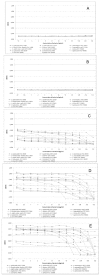Berberine enhances the antibacterial activity of selected antibiotics against coagulase-negative Staphylococcus strains in vitro
- PMID: 24858093
- PMCID: PMC6272005
- DOI: 10.3390/molecules19056583
Berberine enhances the antibacterial activity of selected antibiotics against coagulase-negative Staphylococcus strains in vitro
Abstract
Synergistic interactions between commonly used antibiotics and natural bioactive compounds may exhibit therapeutic benefits in a clinical setting. Berberine, an isoquinoline-type alkaloid isolated from many kinds of medicinal plants, has proven efficacy against a broad spectrum of microorganisms. The aim of the presented work was to assess the antibacterial activity of berberine chloride in light of the effect exerted by common antibiotics on fourteen reference strains of Staphylococccus spp., and to evaluate the magnitude of interactions of berberine with these antistaphylococcal antibiotics. In our study minimum inhibitory concentrations (MIC) of berberine chloride against CoNS ranged from 16 to 512 µg/mL. The most noticeable effects were observed for S. haemolyticus ATCC 29970, S. epidermidis ATCC 12228, S. capitis subsp. capitis ATCC 35661, S. galinarium ATCC 700401, S. hominis subsp. hominis ATCC 27844, S. intermedius ATCC 29663 and S. lugdunensis ATCC 49576. The most significant synergistic effect was noticed for berberine in combination with linezolid, cefoxitin and erythromycin. The synergy between berberine and antibiotics demonstrates the potential application of compound combinations as an efficient, novel therapeutic tool for antibiotic-resistant bacterial infections.
Conflict of interest statement
Authors declare no potential conflict of interest.
Figures
Similar articles
-
Inhibition of Oral Streptococci Growth Induced by the Complementary Action of Berberine Chloride and Antibacterial Compounds.Molecules. 2015 Jul 28;20(8):13705-24. doi: 10.3390/molecules200813705. Molecules. 2015. PMID: 26225951 Free PMC article.
-
[Activity of vancomycin, teicoplanin and linezolid in methicillin resistant coagulase-negative Staphylococci isolates from paediatric blood cultures].Rev Esp Quimioter. 2012 Mar;25(1):25-30. Rev Esp Quimioter. 2012. PMID: 22488538 Spanish.
-
Emergence of cfr-harbouring coagulase-negative staphylococci among patients receiving linezolid therapy in two hospitals in China.J Med Microbiol. 2013 Jun;62(Pt 6):845-850. doi: 10.1099/jmm.0.051003-0. Epub 2013 Feb 28. J Med Microbiol. 2013. PMID: 23449871
-
[Linezolid resistant coagulase-negative Staphylococcus: phenotypical and genotypical characteristics and sensitivity to antibiotic combinations].Enferm Infecc Microbiol Clin. 2013 Aug-Sep;31(7):442-7. doi: 10.1016/j.eimc.2012.10.011. Epub 2012 Dec 20. Enferm Infecc Microbiol Clin. 2013. PMID: 23260384 Spanish.
-
Co-infection by two linezolid-resistant coagulase-negative staphylococci with two different resistance determinants.Scand J Infect Dis. 2012 Dec;44(12):978-81. doi: 10.3109/00365548.2012.704151. Epub 2012 Jul 25. Scand J Infect Dis. 2012. PMID: 22830638
Cited by
-
Antimicrobial characteristics of Berberine against prosthetic joint infection-related Staphylococcus aureus of different multi-locus sequence types.BMC Complement Altern Med. 2019 Aug 16;19(1):218. doi: 10.1186/s12906-019-2558-9. BMC Complement Altern Med. 2019. PMID: 31419978 Free PMC article.
-
Antibacterial and antioxidant properties of sumac extract on methicillin-resistant Staphylococcus aureus.AMB Express. 2024 Oct 3;14(1):111. doi: 10.1186/s13568-024-01759-4. AMB Express. 2024. PMID: 39361209 Free PMC article.
-
Reviewing the Therapeutic Potential of Plant-based Natural Products against Multidrug-resistant Bacteria (MDR).Curr Drug Res Rev. 2025;17(2):191-205. doi: 10.2174/0125899775267934240308065823. Curr Drug Res Rev. 2025. PMID: 40761111 Review.
-
Inhibition of Oral Streptococci Growth Induced by the Complementary Action of Berberine Chloride and Antibacterial Compounds.Molecules. 2015 Jul 28;20(8):13705-24. doi: 10.3390/molecules200813705. Molecules. 2015. PMID: 26225951 Free PMC article.
-
Research progress on pharmacological effects and bioavailability of berberine.Naunyn Schmiedebergs Arch Pharmacol. 2024 Nov;397(11):8485-8514. doi: 10.1007/s00210-024-03199-0. Epub 2024 Jun 18. Naunyn Schmiedebergs Arch Pharmacol. 2024. PMID: 38888754 Review.
References
-
- ECDC/EMEA Joint Technical Report: The bacterial challenge: Time to react. ECDC/EMEA: Stockholm, Sweden. 2009. [(accessed on 17 September 2009)]. Available online: http://www.ecdc.europa.eu/en/publications/Publications/Forms/ECDC DispFo....
-
- Kloos W., Schleifer K.H. Staphylococcus. In: Sneath P.H.A., editor. Bergey’s Manual of Systematic Bacteriology. volume 2. Williams & Wilkins; Baltimore, MD, USA: 1986. pp. 1013–1035.
MeSH terms
Substances
LinkOut - more resources
Full Text Sources
Other Literature Sources
Medical
Molecular Biology Databases
Miscellaneous


